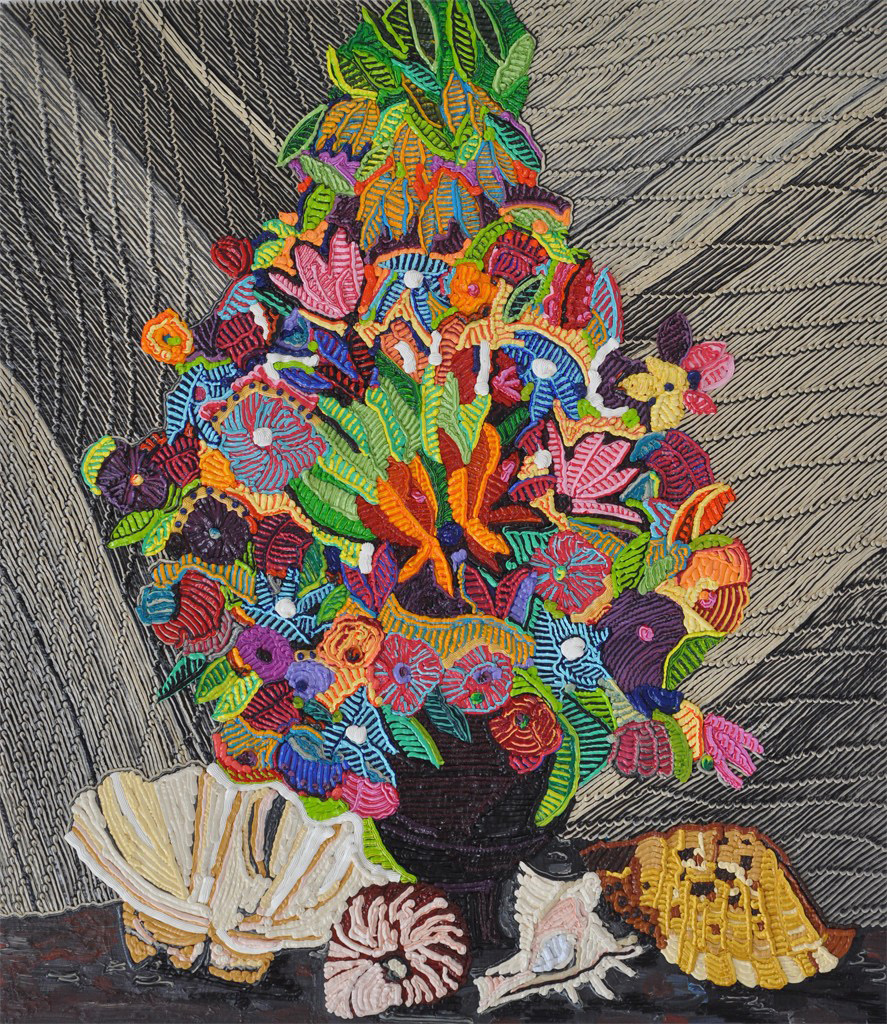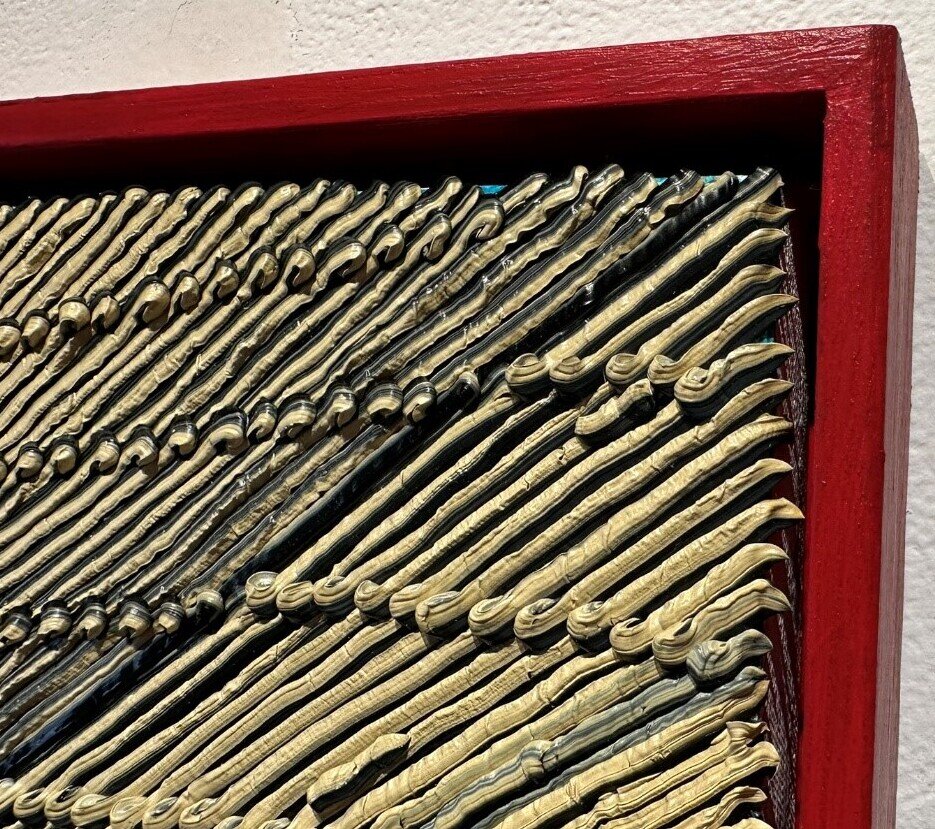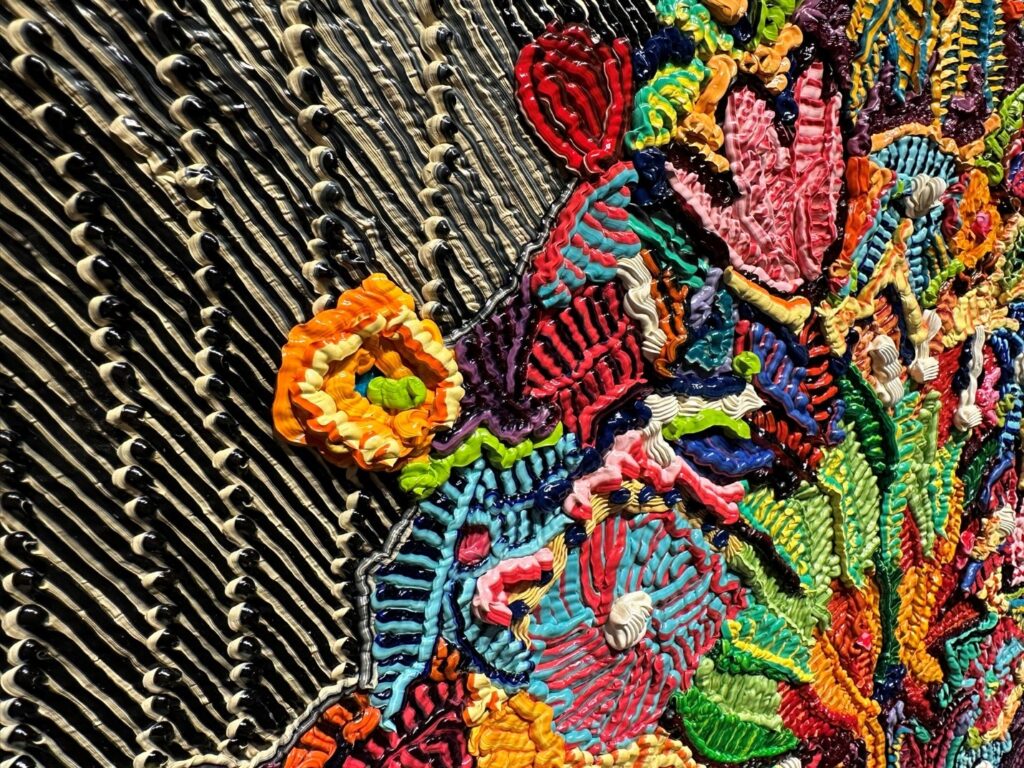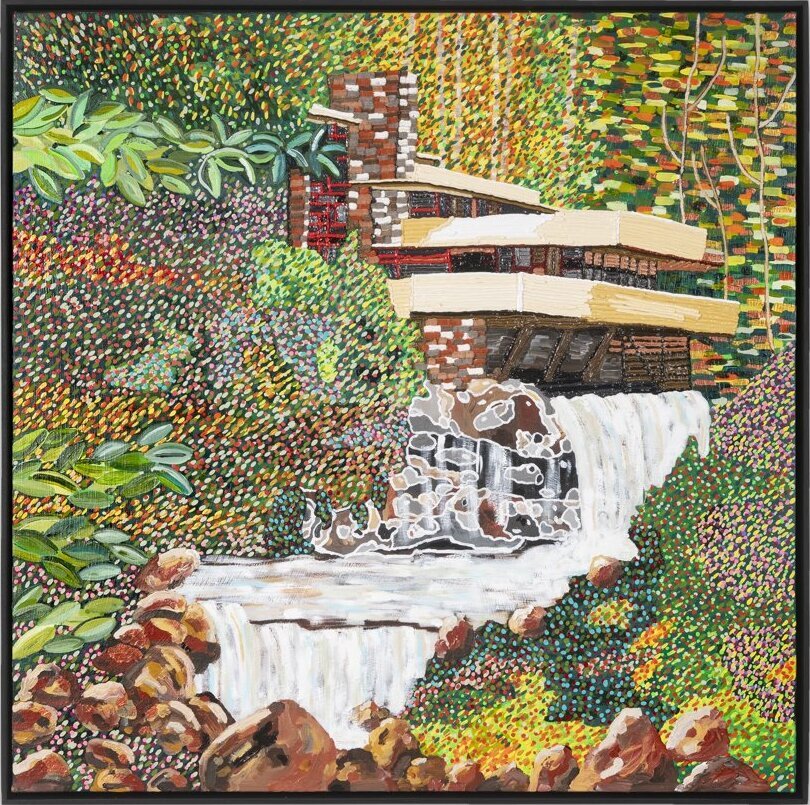It’s so much more than landscapes and flowers. In Caroline Larsen’s show A Traveler’s Garden at General Hardware Contemporary, you’ll encounter vibrant gardens — florid and full of life — but that’s merely the pretext. What these paintings are about, is not so much the subject matter, but rather the process, craft, and creative experimentation within the discipline of painting. The real spectacle isn’t the garden; it’s how she builds it.
At first glance, Larsen’s work might not register as paintings at all. You could be deceived into thinking they’re made from fabric. Take “Still Life with Shells” for example. The surface is thickly textured, with colour applied in linear bands that suggest embroidery. From a distance, you’d be forgiven for mistaking it as a tapestry, some kind of intricately woven textile rather than paint on canvas.
Caroline Larsen, Still Life with Shells, 2018 Oil on canvas, 31 x 27 inches. Courtesy of General Hardware Contemporary
It is only upon closer inspection that the actual process is revealed. All these linear elements are in fact made up of paint — thick oil paint. It’s been applied in strands using a cake decorating bag and nozzle. The background surface around the centre is built up of a field of thin lines terminated in little swirls. Looking even closer, you’ll see that the lines are not monochrome. The painting bag has been packed with two colours — exiting the nozzle like striped toothpaste. The process is taken to the edge of the canvas and in some cases a little bit past it. Delicate tendrils of paint are left hanging, protected only by the frame around the edge.
You’ll have to supress the urge to touch the surface. The thick oil paint looks like it could still be wet. Apparently, these paintings can take months to dry. Even though this piece is from 2018, it looks like the paint is freshly applied.
Caroline Larsen, Still Life with Shells, detail. Photo: Mikael Sandblom
The painting’s focal point is a bouquet of flowers, rendered with lines of paint laid down in meticulous, linear patterns. The palette is notably restrained — composed of a fixed set of pigments. Various gradations and hues are achieved by laying down a pattern of unblended colours next to each other.
The effect is a play of perception. From a distance, these patterns resolve into a seemingly rich range of hues, as the eye mixes the unblended colors into subtle tonal shifts. But step closer, and what seemed like unified shades dissolve into a patchwork of distinct pigments. Consider the greens in the leaves. What appears from afar as a complex variety of hues — cool shadows, bright highlights — unravels up close into thin streaks of yellow, blue, and green, teasing the eye with a kind of chromatic alchemy.
Caroline Larsen, Still Life with Shells, detail. Photo: Mikael Sandblom
When engaging with representational artwork, there’s a threshold — a moment determined by your proximity to the surface — where the illusion of the depicted image dissolves, and you’re left with the raw materiality of the surface, the material and the marks laid down by the artist.
It’s when you’re within this perceptual horizon that you’re engaging with the physical craft of painting. Pay close attention and you can follow the process of the artist step by step. You become a witness to the work being created.
Caroline Larsen, Falling Water, 2024, oil on canvas, 44 x 44 inches. Courtesy of General Hardware Contemporary
Recently Larsen has been introducing more variations in her technique. “Falling Water” is a painting from this year. The image is of the famous Frank Lloyd Wright building, seen from that iconic angle downstream from the waterfall. Hung at the far end of the gallery, you approach the painting at some distance. As you get closer, the image begins to atomize. The perspective breaks down and colours and texture become the dominant elements. You become aware of the paint and in this case, the variety of application. The waterfall is painted in loose thick strokes while the foliage is made up of small dots of colour. The wet rocks next to the stream are rendered with white outlines.
Caroline Larsen, Falling Water, detail. Photo: Mikael Sandblom
The building itself has been ‘constructed’ on the canvas. The cantilevered balconies are built up in thick lines of oil paint. The stonework on the vertical element of the building has been applied with a patterned nozzle as individual blocks of paint and the bright red mullions have been extruded in thick relief.
Caroline Larsen, Falling Water, detail. Photo: Mikael Sandblom
In “Falling Water” Larsen has used both acrylic and oil paints. The foliage dots were painted first. Acrylic’s faster drying time allows Larsen to layer these areas relatively quickly. The fact that acrylics dry flatter than oil also provides a contrast to the architecture at the centre of the painting. This building is in Pennsylvania and is surrounded by temperate forest, familiar to us here in Ontario. The vibrant pigments in the painting, even if inspired by fall colours, must be a partial invention of the artist. So again, the image is merely a structure for the true content of the painting which is pattern, colour and texture.
Painting is a medium that seems perennially capable of reinvention, always finding new ways to assert its relevance. Caroline Larsen’s work exemplifies this capacity for renewal. Rooted firmly in the tradition of paint on canvas, her subject matter — gardens and flowers — draws from a long history of representation. Yet Larsen’s approach to the material transforms the familiar into something strikingly fresh.
What she does with paint is both a nod to tradition and a leap away from it. By applying pigment in ways that evoke craft techniques — embroidery, weaving — she pushes the limits of what paint can do while staying within the framework of its historical conventions. It’s a dialogue with the past, but one that speaks with a distinctly contemporary voice, proving once again that painting, for all its history, is far from exhausted.
Mikael Sandblom
*Exhibition information: Caroline Larsen, A Traveler’s Garden, September 14 – October 12, 2024, 1520 Queen Street West, Toronto. Gallery hours: Wed – Sat 12 – 5 pm.






